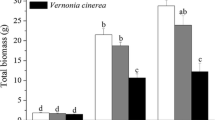Abstract
At their altitudinal limits at 950 m elevation,Eupatorium adenophorum was more susceptible to density-dependent mortality but plasticity of individual organs including reproductive growth was more adversely affected inEupatorium odoratum. In mixtures,Eupatorium adenophorum had an edge overEupatorium odoratum suggesting that the former checks the upper altitudinal limit of the latter.Eupatorium adenophorum andEupatorium riparium coexist well in their mid-altitudinal range of 1500 m. In pure stands,Eupatorium adenophorum was more susceptible to density stress thanEupatorium riparium. Eupatorium riparium was more aggressive thanEupatorium adenophorum in the mixture of increased interspecific competition. In mixtures, these two sets of competing species are less affected than could be expected from the effect of crowding; they, perhaps, occupy different ecologic niches.
Similar content being viewed by others
References
Bergh J P van den 1968 An analysis of yields of grasses in mixed and pure stands;Agric. Res. Rep. 714 1–71
Bergh J P van den and Breakhekee W G 1978 Coexistence of plant species by niche differentiation; inStructure and Functioning of Plant Populations (eds) A H J Freysen and J M Woldendorp (Amsterdam: North-Holland Publ. Co.) pp 125–138
Bradshaw A D 1965 Evolutionary significance of phenotypic plasticity in plants;Adv. Genet. 13 115–155
Deschenes J M 1974 Intraspecific competition in experimental populations of weeds;Can. J. Bot. 52 1415–1421
Dev P 1981Contributions to the comparative Biology of Eupatorium species, Ph.D. thesis, North-Eastern Hill University, Shillong
de Wit C T 1960 On competition;Versl. Landouwkd. Onderz. Nad. 66 1–82
Harper J L 1961 Approaches to the study of plant competition; inmechanisms in Biological Competition (ed) F L Milthorpe (Cambridge: University Press) pp 1–39
Harper J L and Chancellor A P 1959 The comparative biology of closely related species living in the same area IV Rumex. Interference between individuals of one and two species;J. Ecol. 47 679–695
Harper J L and McNaughton I H 1962 The comparative biology of closely related species living in the same area VII. Interference between individuals in pure and mixed populations ofPapaver species;New Phytol. 61 175–188
Kushwaha S P S, Ramakrishnan P S and Tripathi R S 1981 Population dynamics ofEupatorium odoratum in successional environments following slash and burn agriculture;J. Appl. Ecol. 18 529–535
Marshall D R and Jain S K 1969 Interference in pure and mixed populationsAvena fatua andA. barbata;J. Ecol. 57 251–270
Mishra B K and Ramakrishna P S 1983 Secondary succession subsequent to slash and burn agriculture at higher elevations of north-east India;Acta. Oecologica/Oecol. Appl. 4 95–107
Ramakrishnan P S and Gupta U 1972 Nutrient factors influencing the distribution of two closely related species ofArgemone;Weed Res. 12 234–240
Ramakrishnan P S and Jeet N 1972 Competitive relationship existing between two closely related species ofArgemone living in the same area;Oecologia 9 279–288
Ramakrishnan P S and Kumar S 1971 Productivity and plasticity of wheat andCynodon dactylon (L.) Pers. in pure and mixed stands;J. Appl. Ecol. 8 85–98
Ramakrishnan P S and Mishra B K 1981 Population dynamics ofEupatorium adenophorum Spreng. during secondary succession after slash and burn agriculture (jhum) in north-eastern India;Weed Res. 22 77–84
Raynal D J and Bazzaz F A 1975 The contrasting life cycle strategies of three annuals found in abandoned fields in Illinois;J. Ecol. 63 587–596
Saxena K G and Ramakrishnan P S 1984 Herbaceous vegetation development and weed potential in slash and burn agriculture in north-eastern India;Weed Res. 24 135–142
Toky O P and Ramakrishnan P S 1983 Secondary succession following slash and burn agriculture in north-eastern India I. Biomass, litterfall and productivity;J. Ecol. 71 735–745
Author information
Authors and Affiliations
Rights and permissions
About this article
Cite this article
Dev, P., Ramakrishnan, P.S. Coexistence of closely relatedEupatorium species. I.Eupatorium odoratum L. versusEupatorium adenophorum Spreng. andEupatorium adenophorum Spreng. versusEupatorium riparium Regel. at different altitudes. Proc. Indian Acad. Sci. 97, 165–176 (1987). https://doi.org/10.1007/BF03053324
Received:
Revised:
Issue Date:
DOI: https://doi.org/10.1007/BF03053324




